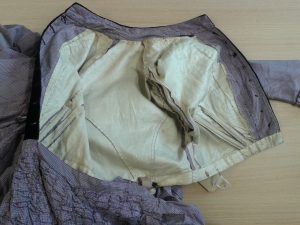How did a Rwandan doll end up in a Brighton teaching collection? Final year Fashion and Dress History student Emmy Sale investigates

Figure 1. Front view Doll made in Kigali, Rwanda, 2008-2009. Cotton fabrics, stuffed with waste-rice stuffing and embroidery detailing. Handmade by a young boy as part of a Tailoring project run by the Kinamba Project. Purchased from Charity Shop in Brighton. University of Brighton Teaching Collection
Ever wondered how objects can travel around the world? Or what happens to souvenirs when they are discarded? This doll from the University of Brighton Dress and Textiles Teaching Collection has made a fascinating journey from Rwanda to Brighton. The doll was purchased by Professor Lou Taylor for just £3 from a Brighton charity shop. The use of African wax print fabric in its construction suggested the doll to be from West African, but research proved otherwise. Instagram posts of similar souvenir dolls posted by tourists suggested Rwandan origins. However, when the dolls were found on www.africanbags.org, this provenance was confirmed. Significantly, the website attributed the doll to the “Kinamba Project” in Kigali, Rwanda.
The Kinamba Project was set up in 2005, aiming to help the poor and vulnerable in Kigali, after the community’s devastation following the 1994 genocide. One way the project helps children and adults is through a tailoring project, which teaches sewing skills to individuals to create a source of income. The Project’s founder, Meg Fletcher, was able to shed more light on the significance of the doll’s manufacture. She explained that the object was made by a young orphan who was looking after a disabled man in exchange for food and a place to sleep. The ‘orphan’ is now a successful and enterprising young man. Today he produces stuffed animals, mobiles and bags, all made from fabrics purchased from local wholesale outlets, and stuffed with waste-rice sacking. From those small beginnings, he was able to employ three people, to purchase a piece of land and to build a house. With the support of the Kinamba Project, the benefits for the people of Kigali of manufacturing these souvenir dolls can be comprehended.
This doll has undergone a journey: from something made to help an individual’s life in Rwanda, bought as a tourist souvenir, later donated to a British charity shop and purchased by a professor for use in dress history research. The research was conducted for a case-study project entitled “Not Just a Souvenir: Dolls of the World.” The teaching collection holds many other dolls from around the world and it is hoped that their narratives will also be researched and revealed by students in the future.
E.Sale1@uni.brighton.ac.uk





